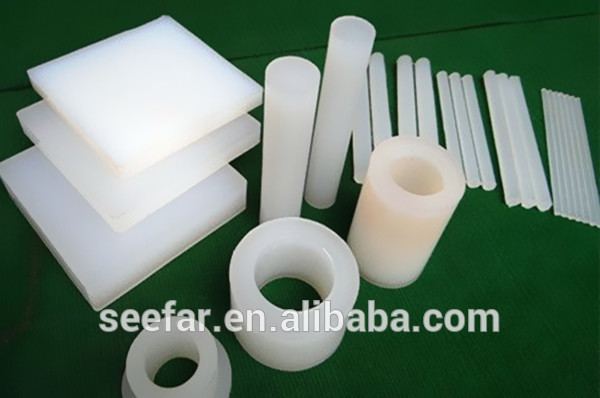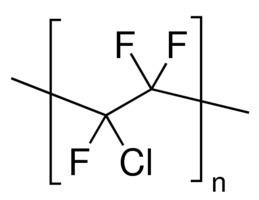Abbreviations PCTFE, PTFCE | Formula (C2ClF3)n | |
 | ||
Polychlorotrifluoroethylene meaning
Polychlorotrifluoroethylene (PCTFE or PTFCE) is a thermoplastic chlorofluoropolymer with the molecular formula (CF2CClF)n, where n is the number of monomer units in the polymer molecule. It is similar to polytetrafluoroethene (PTFE), except that it is a homopolymer of the monomer chlorotrifluoroethylene (CTFE) instead of tetrafluoroethene. It has the lowest water vapor transmission rate of any plastic.
Contents
- Polychlorotrifluoroethylene meaning
- History
- Trade names
- Synthesis
- Properties
- Differences from PTFE
- Applications
- References

History
It was discovered in 1934 by Fritz Schloffer and Otto Scherer who worked at IG Farben Company, Germany.
Trade names

After World War II, PCTFE was commercialized under the trade name of Kel-F 81 by M W Kellogg company in early 1950s. The name Kel-F were derived from Kellogg and Fluoropolymer, which also represents other fluoropolymers like the copolymer poly(chlorotrifluoroethylene-co-vinylidene fluoride) (Kel-F 800). These were acquired by 3M Company in 1957. But 3M discontinued manufacturing of Kel-F by 1996.

PCTFE resin is now manufactured in different trade names such as Neoflon PCTFE from Daikin or Aclon from Allied Signal. However, Kel-F remains the most commonly used trade name still today. PCTFE films are sold under the tradename Aclar by Allied Signal. Tradenames of PCTFE in other manufacturing companies include Hostaflon C2 from Hoechst, Fluon from ICI, Voltalef from Arkema, Aclar from Honeywell, Plaskon from Allied Chemical Corporation and Halon from Ausimont USA.
Synthesis

PCTFE is an addition homopolymer. It is prepared by the free radical polymerization of chlorotrifluoroethylene (CTFE) and can be carried out by solution, bulk, suspension and emulsion polymerization.
Properties

PCTFE has high tensile strength and good thermal characteristics. It is nonflammable and the heat resistance is up to 175 °C. It has a low coefficient of thermal expansion. The glass transition temperature (Tg) is around 45 °C.
PCTFE has one of the highest limiting oxygen index (LOI). It has good chemical resistance. It also exhibits properties like zero-moisture absorption and non wetting.
It does not absorb visible light. When subjected to high energy radiation it undergoes, like PTFE, degradation. It can be used as a transparent film.
The presence of a chlorine atom, having greater atomic radius than that of fluorine, hinders the close packing possible in PCTFE. This results in having a relatively lower melting point among fluoropolymers and it is around 210 - 215 °C.
PCTFE is resistant to the attack by most chemicals and oxidizing agents; a property which is exhibited due to the presence of high fluorine content. However, it swells slightly in halocarbon compounds, ethers, esters and aromatic solvents. PCTFE is resistant to oxidation because it does not have any hydrogen atoms.
PCTFE exhibits a permanent dipole moment due to the molecular asymmetry of its repeating unit. This dipole moment is perpendicular to the carbon chain axis.
Differences from PTFE
PCTFE is a homopolymer of chlorotrifluoroethylene (CTFE), whereas PTFE is a homopolymer of tetrafluoroethylene. The monomers of the former differs from that of latter structurally by having a chlorine atom replacing one of the fluorine atoms. Hence each repeating unit of PCTFE have a chlorine atom in place of a fluorine atom. This accounts for PCTFE to have less flexibility of chain and hence higher glass transition temperature. PTFE has a higher melting point and is more crystalline than PCTFE, but the latter is stronger and stiffer. Though PCTFE has excellent chemical resistance, it is still less than that of PTFE. PCTFE has lower viscosity, higher tensile strength and creep resistance than PTFE.
PCTFE is injection moldable and extrudable whereas PTFE is not.
Applications
PCTFE finds majority of its application due to two main properties; water repulsion and chemical stability. PCTFE films are used as a protective layer against moisture. These include,
Due to its chemical stability, it acts as a protective barrier against chemicals. It is used as a coating and prefabricated liner for chemical applications. PCTFE is also used for laminating other polymers like PVC, polypropylene, PETG, APET etc. It is also used in transparent eyeglasses, tubes, valves, chemical tank liners, O-rings, seals and gaskets.
PCTFE is used to protect sensitive electronic components because of its excellent electrical resistance and water repulsion. Other uses include flexible printed circuits and insulation of wires and cables.
Low molecular weight PCTFE waxes, oils and greases find their application as inert sealants and lubricants. They are also used as gyroscope flotation fluids and plasticizers for thermoplastics.
